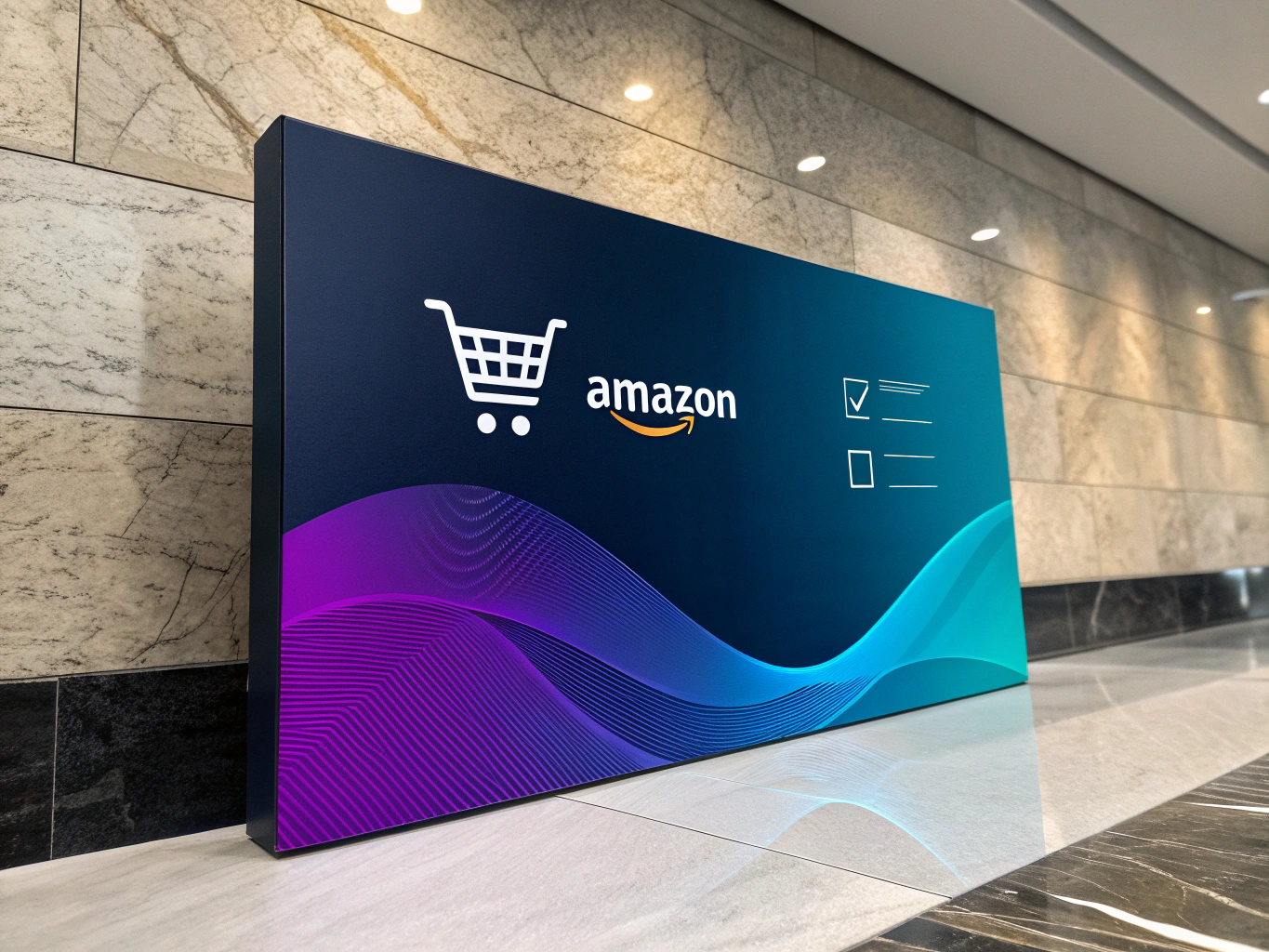Let’s talk about something that’s been floating around the ecommerce world like a persistent rumor – getting an Amazon storefront. Some say it’s impossible without a trademark, others swear they got approved overnight with just 100 Instagram followers. The truth? It’s somewhere in between, and it’s a lot more nuanced than most people think.

I’ve spent years helping brands navigate the maze of Amazon’s ecosystem, and if there’s one thing I’ve learned, it’s that Amazon’s requirements are like quantum physics – they seem to exist in multiple states simultaneously. But don’t worry, I’m here to break it down in a way that actually makes sense.
What Exactly is an Amazon Storefront (And Why Should You Care)?
Think of an Amazon storefront as your digital retail space within the world’s largest shopping mall. It’s not just another product listing – it’s your brand’s home on Amazon, complete with your own URL, customizable pages, and the ability to showcase your products however you want. Pretty sweet, right?
But here’s where it gets interesting: there isn’t just one type of Amazon storefront. There are actually three distinct flavors, each with its own set of rules and requirements:
- Brand Registry Storefronts (the traditional route)
- Individual Seller Storefronts (yes, they exist)
- Influencer Storefronts (the new kid on the block)
Getting Started: The Prerequisites for Your Amazon Storefront

Remember when I mentioned quantum physics? Well, here’s where things get particularly interesting. The “official” requirements for getting an Amazon storefront are both rigid and surprisingly flexible, depending on which path you’re taking.
The Brand Registry Route
This is what Amazon wants you to do – the “proper” way, if you will. You’ll need:
- A registered trademark (US Patent and Trademark Office or equivalent)
- A Professional Seller account ($39.99/month)
- Brand Registry enrollment
But here’s a little secret that most guides won’t tell you: some sellers have reported successfully creating storefronts without being enrolled in Brand Registry. Is it a glitch? A feature? Amazon’s not saying, but it’s worth keeping in mind if you’re just starting out.
The Influencer Program Path
This is where things get really interesting. The Amazon Influencer Program has become an increasingly popular way to get a storefront, especially for content creators. The requirements here are refreshingly different:
- An active social media presence (YouTube, Instagram, TikTok, or Facebook)
- Engaged followers (quality over quantity, though Amazon’s never specific about numbers)
- Regular content creation
And contrary to popular belief, you don’t need millions of followers. I’ve seen creators with modest but engaged followings get approved while some with massive follower counts get rejected. It’s all about engagement and authenticity.
The Individual Seller Route
This is the path less traveled, and honestly, it’s a bit like finding a secret passage in a video game. While Amazon doesn’t actively promote this option, some sellers have managed to create basic storefronts with just an Individual Seller account. It’s more limited in functionality, but it’s a legitimate starting point if you’re testing the waters.
The key thing to remember is that Amazon’s requirements aren’t just arbitrary hoops to jump through – they’re designed to ensure quality and authenticity in their marketplace. Whether that system works perfectly is debatable (spoiler: it doesn’t), but understanding the reasoning behind it helps navigate the process more effectively.
Prerequisites for Getting an Amazon Storefront
Let’s talk about what it actually takes to get an Amazon storefront – and no, you won’t need to sacrifice your firstborn to the e-commerce gods. Though sometimes dealing with Amazon’s requirements might feel that way.
Brand Registry Requirements: The Golden Ticket
Remember how Charlie needed a golden ticket to get into Willy Wonka’s factory? Well, your golden ticket to an Amazon storefront is typically the Brand Registry program. And just like Wonka’s chocolate factory, there are some hoops to jump through.
First things first – you’ll need a registered trademark. I know, I know, it sounds about as fun as watching paint dry. But here’s the thing: this trademark is your shield in the wild west of e-commerce. It’s like having a bouncer for your brand, keeping the copycats and counterfeiters at bay.
The “But Wait, There’s More” Department
Here’s something interesting I’ve noticed recently – some sellers have managed to create storefronts without being in the Brand Registry. It’s like finding a secret passage in the Amazon maze. While this might work occasionally (probably due to system quirks), I wouldn’t bet my business strategy on it.
Setting Up Your Amazon Storefront: The Nuts and Bolts

Once you’ve got your trademark sorted (or if you’re one of the lucky ones who found a workaround), it’s time to actually build this thing. Think of it as creating your own mini-website within Amazon’s ecosystem – except with more rules than a boarding school.
Account Setup: Professional vs. Individual
You’ll need to choose between a Professional Seller account ($39.99/month) or an Individual Seller account (pay-as-you-go at $0.99 per item). If you’re serious about this, go Professional. It’s like choosing between a Swiss Army knife and a plastic spoon – sure, both can technically cut things, but one’s clearly better equipped for the job.
The documentation requirements are pretty straightforward: business registration details, tax info, and bank account information. Nothing too scary – just the usual “prove you’re a real business” stuff.
The Amazon Influencer Program: A Different Beast
Now, if you’re more interested in the influencer route, that’s a whole different ballgame. The Amazon Influencer Program is like the cool kids’ table of Amazon storefronts. You’ll need a decent social media following (though Amazon’s deliberately vague about exact numbers), and your content needs to be engaging enough to make a teenager look up from their phone.
The application process is surprisingly straightforward: connect your social media accounts, wait for review (usually 1-5 business days), and cross your fingers. Pro tip: having genuine engagement matters more than raw follower counts. I’ve seen creators with 5,000 highly engaged followers get approved while others with 50,000 ghost followers get rejected.
Getting Creative with Your Store Design
Once you’re in, you’ll get access to Amazon’s Store Builder tools. It’s like WordPress meets Canva, but with more restrictions and less intuitive interface (hey, nobody’s perfect, right?). You can create multiple pages, customize layouts, and showcase your products in various ways.
The key here is to think like a customer. What would make you stop scrolling? What information would you need to make a purchase decision? Your storefront should answer these questions before they’re even asked.
Remember those product photos you’ve been using? Time to step up your game. Amazon’s creative guidelines are stricter than a militant librarian, but for good reason. Clean, professional images with proper lighting and clear backgrounds aren’t just nice-to-have – they’re essential for conversion.
And here’s something most guides won’t tell you: while Amazon’s templates are decent, the magic happens in how you customize them. It’s like cooking – following the recipe gets you a meal, but adding your own twist makes it memorable.
Marketing Your Amazon Storefront Like a Pro
Look, getting your Amazon storefront set up is only half the battle. I’ve seen too many sellers build beautiful storefronts that end up being digital ghost towns. The “if you build it, they will come” approach? Yeah, that doesn’t work here. You need a solid marketing strategy to get eyeballs on your storefront.
On-Platform Marketing Strategies That Actually Work
Let’s talk about Amazon PPC campaigns – they’re like your storefront’s best friend. But here’s the thing: don’t just throw money at sponsored products and hope for the best. Start with Sponsored Brands campaigns that showcase your store’s unique value proposition. Think of it as your digital storefront window – it needs to stop shoppers in their tracks.
A+ Content integration is another powerful tool in your arsenal. It’s like having a premium real estate spot in a digital mall. Use it to tell your brand story, highlight your best products, and create that emotional connection that turns browsers into buyers.
Growing Your Amazon Storefront Beyond the Basics

Amazon Posts is still surprisingly underutilized by most sellers. It’s basically Instagram for Amazon – use it! I’ve seen brands increase their storefront traffic by 40% just by consistently posting engaging content that resonates with their target audience.
Off-Platform Promotion That Drives Results
Here’s where your amazon affiliate marketing game needs to level up. Social media isn’t just about posting pretty pictures – it’s about creating a cohesive narrative that leads people back to your Amazon storefront. Think of your social channels as tributaries feeding into the main river of your Amazon presence.
The Amazon creator hub has become an invaluable resource for storefront owners. It’s like having a Swiss Army knife of marketing tools at your disposal. Use it to track performance, identify trends, and adjust your strategy on the fly.
Advanced Optimization Techniques
Want to know how to become an Amazon influencer? It’s not just about follower count anymore (though you typically need at least 1,000 followers on one platform). The key is engagement and authenticity. I’ve seen creators with smaller, highly engaged audiences outperform those with massive but passive followings.
For those wondering “Can anybody have an Amazon storefront?” – technically yes, but success requires more than just meeting the basic requirements. You need to understand your metrics. Track your:
– Store page views to product detail page clicks ratio
– Category-specific conversion rates
– Customer journey patterns
– Return visitor percentage
Troubleshooting Common Storefront Issues
If you’re asking “Why can’t I have an Amazon storefront?” it’s usually due to one of these common issues:
– Incomplete brand registry process
– Missing trademark documentation
– Insufficient social media presence (for influencer storefronts)
– Account verification problems
The good news? Most of these are fixable. The Amazon affiliate program and Amazon influencer storefront guidelines are pretty straightforward once you understand what’s required.
Future-Proofing Your Storefront
The landscape of affiliate Amazon programs and storefronts is evolving rapidly. We’re seeing new features roll out monthly, from enhanced analytics to AI-powered optimization tools. Stay ahead by:
– Regularly updating your store design
– Testing new content formats
– Engaging with customer feedback
– Monitoring competitor strategies
Remember, your Amazon storefront isn’t just a digital catalog – it’s your brand’s home on the world’s largest marketplace. Treat it like the valuable asset it is. Keep experimenting, keep optimizing, and most importantly, keep focusing on what makes your brand unique.
And for those wondering “Is it free to have an Amazon storefront?” – while the basic setup might be free, success requires investment. Not just money, but time, creativity, and consistent effort. But when done right? The ROI can be absolutely worth it.
The future of Amazon storefronts is bright, and the opportunities are endless. Whether you’re just starting out or looking to scale, remember: success on Amazon isn’t about following a perfect formula – it’s about creating genuine connections with your customers and continuously adapting to serve them better.
👉👉 Create Photos, Videos & Optimized Content in minutes 👈👈
Related Articles:
- How to Make an Amazon Storefront: A Beginner’s Guide
- Influencer Amazon Storefront: Your Guide to Success
- How to Become Amazon Influencer & Earn in 2024 – ProductScope AI
Frequently Asked Questions
Can anybody have an Amazon storefront?
Not everyone can have an Amazon storefront. It is designed for Amazon sellers and influencers who meet specific criteria set by Amazon. Typically, you need to be part of the Amazon Influencer Program or have a registered seller account to create a storefront.
How many followers do you need to get an Amazon storefront?
Amazon does not specify an exact number of followers required to get an Amazon storefront, but having a substantial and engaged following on social media platforms like YouTube, Instagram, or TikTok is essential. The decision is based on the reach and influence of your content rather than a specific follower count.
Is it free to have an Amazon storefront?
Yes, it is free to create an Amazon storefront if you qualify. However, you may incur costs related to maintaining your status as an influencer or seller, such as marketing expenses or Amazon’s selling fees if you are a vendor.
Why can’t i have an Amazon storefront?
If you can’t have an Amazon storefront, it may be because you don’t meet the eligibility criteria, such as having a significant online following or an active seller account. Additionally, your application might be pending review, or you might need to improve your engagement metrics.
What are the qualifications to have an Amazon storefront?
To qualify for an Amazon storefront, you typically need to be part of the Amazon Influencer Program or have an established seller account. This involves having a strong social media presence with meaningful engagement or being a registered brand on Amazon with a track record of selling products.
About the Author
Vijay Jacob is the founder and chief contributing writer for ProductScope AI focused on storytelling in AI and tech. You can follow him on X and LinkedIn, and ProductScope AI on X and on LinkedIn.
We’re also building a powerful AI Studio for Brands & Creators to sell smarter and faster with AI. With PS Studio you can generate AI Images, AI Videos, Chat and Automate repeat writing with AI Agents that can produce content in your voice and tone all in one place. If you sell on Amazon you can even optimize your Amazon Product Listings or get unique customer insights with PS Optimize.
🎁 Limited time Bonus: I put together an exclusive welcome gift called the “Formula,” which includes all of my free checklists (from SEO to Image Design to content creation at scale), including the top AI agents, and ways to scale your brand & content strategy today. Sign up free to get 200 PS Studio credits on us, and as a bonus, you will receive the “formula” via email as a thank you for your time.
